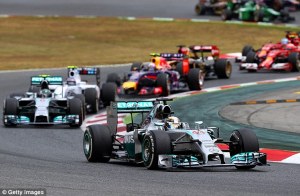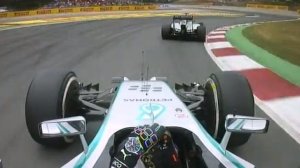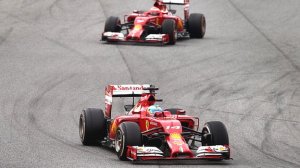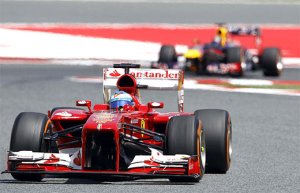So, Lewis Hamilton has made it four wins in a row with a hard fought victory in Barcelona. It certainly wasn’t easy, with Nico Rosberg closely shadowing his Mercedes team-mate for the entire race, eventually crossing the line just 0.6 seconds behind the Briton. While there was none of the dicing that we saw in Bahrain, Hamilton’s margin of victory was certainly similar, as was the significant nature of the win.
Bahrain and Spain are both theoretically Rosberg tracks; tracks that play to the strengths of the German. At both of these tracks Hamilton has now beaten his team-mate – psychologically, you suspect, this must give him a massive boost.
Just like in Bahrain, Hamilton was struggling in Barcelona. While Rosberg beat him to pole in Bahrain, though, this time Hamilton somehow managed to wrestle pole position away from his team-mate. The 2008 world drivers’ champion had been delighted with his car on Friday as he dominated both free practice sessions, but it was a different story come Saturday.
In free practice three, and more importantly in qualifying, Rosberg seemed to have the advantage over Hamilton, who was struggling with the setup changes that had been made to his Mercedes. In the qualifying top ten shoot out, though, Hamilton found some extra speed and snatched the pole position that Rosberg must have thought was his.
Pole position is seen as hugely important in Barcelona, where overtaking opportunities can be limited. And so it proved. Hamilton got away to the perfect start and Rosberg was forced to slot in behind him. Things remained close in the first stint, which the gap between the two Mercedes hovered at around the two second mark – well clear of the chasing pack headed by Red Bull’s Daniel Ricciardo.
This, of course, meant that Hamilton got the advantage of pitting first, just like he did in Bahrain. Again mirroring the Bahrain race, Hamilton took the option tyres for his second stint while Rosberg switched to the hard, prime tyres. Hamilton, on the supposedly quicker tyres was unable to extend the gap to his team-mate in the second stint, though. He was struggling with the setup of the car, complaining about severe oversteer over team radio, while Rosberg seemed to have the car exactly where he wanted it to be.
As both drivers made their second and final pit stops Hamilton had a four second advantage over Rosberg, who now had the faster option tyres on his car, while Hamilton had to manage with the slower primes, again just like in Bahrain. This time, though, there was no safety car to close down the gap and spice up the action. Rosberg had 20 laps to close down and pass his team-mate.
He did the former brilliantly. The gap between the team-mates see sawed over the closing laps, but ultimately Rosberg was closing down his team-mate. As we entered the final couple of laps the German enjoyed the advantage of DRS as he closed to within a single second of Hamilton. It looked inconceivable that Hamilton would again be able to hang on to victory.
The Stevenage-born racer had other ideas, though. While Rosberg certainly got close, he was unable to pass Hamilton or even make an attempt to do so. As Hamilton took the chequered flag he also took the lead of the world drivers’ championship, yet another huge psychological blow. Hamilton has managed to beat Rosberg in two races where the German was clearly the quicker driver. Rosberg must wonder what he has to do to beat the Englishman.
The rest of the field, though, will be wondering what they have to do to beat Mercedes. While the battle between Rosberg and Hamilton was a close one, the battle between Mercedes and the rest was anything but. Daniel Ricciardo finished almost 50 seconds behind the Mercedes cars with his team-mate, Sebastian Vettel, over 25 seconds further back in fourth position, having driven brilliantly to claw his way up from 15th on the grid after a transmission problem in qualifying and a grid penalty for changing his gearbox.
In the preceding four races of the season the gap between the winning Mercedes and the first non-Silver Arrow was around 20-25 seconds. In Spain, that gap doubled. While Hamilton has struck a psychological blow over Rosberg, Mercedes are on the verge of a knockout over the rest of the field. Spain – the start of the European season – is the race where the teams traditionally bring big upgrade packages to their cars. With a three week gap between the races in China and Spain, the rest of the field would have been hoping to close the gap. Instead, that gap has doubled.
Yes, you can argue that other factors contributed to the bigger gap in Spain. Track characteristics, maybe, or the fact that Ricciardo was being held up behind the Williams of Valtteri Bottas, which eventually finished fifth, in the first stint of the race. However, you could also argue that the gap might have been even larger had Hamilton been happy with the setup of his car. Whatever the case, Mercedes now have a lead of over 100 points over second placed Red Bull Racing in the world constructors’ championship.
Ferrari, boosted by Fernando Alonso’s third place last time out in China, must feel utterly demoralised in third place in the constructors’ standings. In Spain they were nowhere, qualifying in sixth and seventh positions and finishing the race in the same positions, albeit with Alonso managing to get ahead of his team-mate Raikkonen, after being out qualified by the Finn. More embarrassingly for the Scuderia, though, is the fact that Raikkonen was lapped and Alonso only escaped that indignity by a few seconds, finishing nearly 90 seconds behind Hamilton’s winning Mercedes.
The tight and twisty streets of Monaco will minimise the Silver Arrows’ power advantage, though, and the rest of the pack will hold out some hope that they’ll be able to take the fight to Mercedes in two weeks’ time. Both championships look out of reach already, though. It’ll be a battle between Hamilton and Rosberg throughout the season, but you suspect that the German needs to beat Hamilton again very soon.
Hamilton has the momentum and the psychological advantage. You suspect that he’d like nothing more than to rub it in around the streets of Monaco, where Rosberg won last season.








